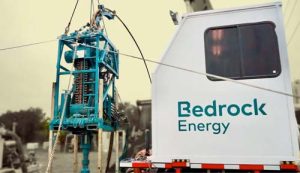Geothermal Heat Pumps Are Helping Clean Up City Buildings
Initiatives in Austin, New York City, and beyond are aiming to curb costs and boost adoption of geothermal heating and cooling to reduce CO2 from buildings.
Late last year in Austin, Texas, big blue rigs rolled up to a sunbaked parking lot and started boring holes deep into the ground. Bedrock Energy, a geothermal startup, was deploying its novel drilling technology for the first time, near a block of low-slung commercial buildings on South Congress Avenue.
Over the following two months, Bedrock’s team drilled 11 holes beneath the torn-up parking lot, each one reaching 800 feet deep. Now those holes form the backbone of a geothermal heating and cooling system, which can extract heat from, or pump heat into, the ground to keep temperatures comfortable inside an adjacent office space — without directly using fossil fuels.
Joselyn Lai, the startup’s co-founder and CEO, said a more conventional drilling setup would’ve required drilling 30 holes, to depths of 300 feet, to deliver the same amount of heating and cooling. But the parking lot isn’t wide enough to accommodate a project like that. By using its subsurface modeling software and powerful, sensor-equipped drilling tools, Bedrock was able to design a system that fit.
“Urban buildings are where most of our carbon emissions come from in the built environment,” Lai told Canary Media. She said the company is aiming to “expand the addressable, serviceable market” for geothermal heating and cooling so that even buildings in dense areas can harvest energy hiding below the surface. 04-29-24







